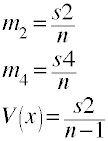In describing the shape statistical distributions kurtosis refers to the “tailedness” of a distribution.
Different statistical packages compute somewhat different values for kurtosis. What are the different formulas used and which packages use which formula?
We will begin by defining two different sums of powered deviation scores. The first one, s2, is the sum of squared deviation scores while s4 is the sum of deviation scores raised to the fourth power.

Next, we will define m2 to be the second moment about the mean of x and m4 to be the fourth moment. Additionally, V(x) will be the unbiased estimate of the population variance.

Now we can go ahead and start looking at some formulas for kurtosis. The first formula is one that can be
found in many statistics books including Snedecor and Cochran (1967).
It is used by SAS in proc means when specifying the option vardef=n. This formula
is the one most commonly found in general statistics texts. With this definition
a perfect normal distribution would have a kurtosis of zero.

The second formula is the one used by Stata with the summarize command. This definition of
kurtosis can be found in Bock (1975). The only difference between formula 1 and formula 2 is the
-3 in formula 1. Thus, with this formula a perfect normal distribution would have a kurtosis of three.

The third formula, below, can be found in Sheskin (2000) and is used by SPSS and SAS proc means when
specifying the option vardef=df or by default if the vardef option is omitted. This
formula uses the unbiased estimates of variance and of the fourth moment about the mean. The expected
value for kurtosis with a normal distribution is zero.

Examples
Formula 1 — SAS
data test; input x; cards; 1987 1987 1991 1992 1992 1992 1992 1993 1994 1994 1995 ; run; proc means data=test kurtosis vardef=n; run;Analysis Variable : x Kurtosis -------------- -0.2320107 --------------
Formula 2 — Stata
input x 1987 1987 1991 1992 1992 1992 1992 1993 1994 1994 1995 end summ x, detailx ------------------------------------------------------------- Percentiles Smallest 1% 1987 1987 5% 1987 1987 10% 1987 1991 Obs 11 25% 1991 1992 Sum of Wgt. 11 50% 1992 Mean 1991.727 Largest Std. Dev. 2.611165 75% 1994 1993 90% 1994 1994 Variance 6.818182 95% 1995 1994 Skewness -.8895014 99% 1995 1995 Kurtosis 2.767989
Formula 3 — SAS
data test; input x; cards; 1987 1987 1991 1992 1992 1992 1992 1993 1994 1994 1995 ; run; proc means data=test kurtosis vardef=df; run;Analysis Variable : x Kurtosis -------------- 0.4466489 --------------proc means data=test kurtosis; run;Analysis Variable : x Kurtosis -------------- 0.4466489 --------------
Formula 3 — SPSS
data list list/ yr.begin data. 1987 1987 1991 1992 1992 1992 1992 1993 1994 1994 1995 end data. desc /var=all /stat=kurtosis.
References
Bock, R.D. (1975) Multivariate Statistical Methods in Behavioral Research. New York: McGraw-Hill.
Joanest, D.N. and Gill, C.A. (1998) Comparing measures of sample skewness and kurtosis. The Statistician, 47, pp 183-189.
Sheskin, D.J. (2000) Handbook of Parametric and Nonparametric Statistical Procedures, Second Edition. Boca Raton, Florida: Chapman & Hall/CRC.
Snedecor, G.W. and Cochran, W.G. (1967) Statistical Methods, Sixth Edition. Ames, Iowa: Iowa State University Press.
Westfall, P. (2014) Kurtosis as Peakedness, 1905 – 2014. R.I.P. American Statistician, 68(3): 191-195.
